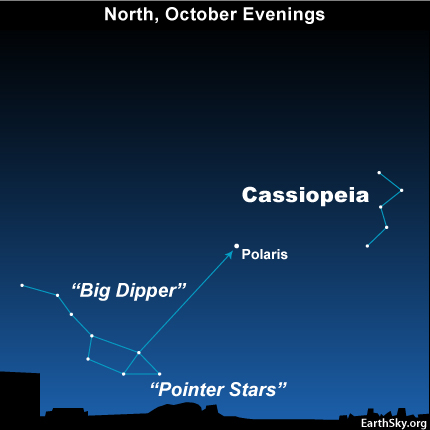Courtesy of EarthSky
A Clear Voice for Science
www.EarthSky.org [1]
 [2]
[2] [3]On October evenings, the Big Dipper resides rather low in the northwest sky, and the W or M-shape constellation Cassiopeia the Queen sits on her throne in the upper northeast sky. These two star formations are like riders on opposite side of a Ferris Wheel. They spin around Polaris, the North Star, once a day. As one rises upward, the other plunges downward – and vice versa.
[3]On October evenings, the Big Dipper resides rather low in the northwest sky, and the W or M-shape constellation Cassiopeia the Queen sits on her throne in the upper northeast sky. These two star formations are like riders on opposite side of a Ferris Wheel. They spin around Polaris, the North Star, once a day. As one rises upward, the other plunges downward – and vice versa.
As evening deepens into late night, the Big Dipper goes downward while Cassiopeia goes upward. By around midnight tonight, Cassiopeia will have circled to the “12 o’clock” position directly above Polaris, and the Big Dipper will have circled to the “6 o’clock” position directly below Polaris. Before dawn tomorrow, the Big Dipper will have moved to “3 o’clock” and Cassiopeia to “9 o’clock.”
Some of you know how to star-hop to Polaris, the North Star, by using the Big Dipper “pointer stars,” as displayed on tonight’s sky chart. Because the Big Dipper handle and Cassiopeia shine on opposite sides of Polaris, an imaginary line from any star on the Big Dipper handle through Polaris reliably points to Cassiopeia.
If you live north of 41 degrees north latitude – the latitude of New York City – the Big Dipper and Cassiopeia are both circumpolar. Circumpolar refers to stars that are always above the horizon (if it’s level) at any time of night all year round. Watch as Cassiopeia rises up and the Big Dipper falls down on these cool autumn evenings.
Written by Bruce McClure [4]
Astronomy Picture of the Day from NASA/JPL [5]
U.S. Naval Observator Astronomical Information cente [7]r
Universe Today [8]
StarDate Online [9]
Sky and Telescope [10]
National Geographic [11]
Space Com [12]
Simostronomy Blog [13]
Amazing Space [14]
The York County Astronomical Society [15]
Scope City [16]